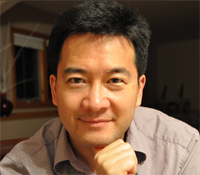People
Ji-Xin Cheng
Professor Biomedical Engineering and Chemistry
Contact Information:
E-mail: jcheng@purdue.edu
Group Page
Education:
B.S., 1994, Department of Chemical Physics, University of Science and Technology of China
Ph. D., 1998, University of Science and Technology of China
Postdoctoral fellow, Hong Kong University of Science and Technology 1999, Harvard University 2000 to 2003.
Research Interests:
Optical spectroscopy has been a powerful tool for quantitative molecular analysis by measuring quantized electronic and vibrational transitions in molecules. Over the past, such measurements were restricted to molecules that are extracted from cells and tissues, or biopsies extracted from a human body. Such point spectroscopy measurements lack the capabilities of tracing molecules in intact, live tissue environment. Spectroscopic imaging by measuring molecular fingerprint spectrum at each pixel, thus providing both molecular information and spatial resolution, would offer a new window for seeing a hidden world of biology. Five to ten years ago, spectroscopic imaging of living systems from single cell to human body was considered to be impossible. This Òmission impossibleÓ can be summarized as the following tasks: (1) Can we perform real time spectroscopic imaging of a live cell? (2) Can we derive meaningful information from the crowded fingerprint spectra recorded from an intact, extremely complicated biological complex? (3) Can we measure a spectrum in vivo from a target tissue that is a few cm underneath the skin?
Research Impact Statement:
My research lab has been tackling the Òmission impossibleÓ very persistently. I have had privilege to work with a group of talented, hardworking postdocs and students. Our recent research endeavours have generated promising solutions allowing for spectroscopic imaging of life. We have two consecutive inventions that enabled fast spectroscopic imaging with a pixel dwell time of 10 microseconds, which is nearly 1 million times faster than conventional Raman spectroscopy. We have successfully bridged multivariate analysis tools with spectroscopic imaging. Such integration has allowed label-free imaging of biomolecules, such as cholesterol, in an intact tissue using their fingerprint bands. We have launched a novel imaging platform based on acoustic detection of chemical bond vibration. Continuous development of this method has allowed us to record a spectrum from a target tissue that is 3 cm deep below the surface.
We continue to employ these advanced instruments to tackle challenging questions in medicine. By leading a highly interdisciplinary team spanning Purdue University, IU School of Medicine, MD Anderson Cancer Center and Dana-Farber Cancer Institute, we recently made a breakthrough in the study of lipid metabolism in aggressive forms of human cancer. In short, we discovered an aberrant cholesterol metabolism in aggressive prostate, pancreatic, breast, and brain cancer, and the list still grows. This discovery opened two transformative opportunities: early diagnosis of aggressive tumour using the altered cholesterol metabolism as a spectroscopic imaging marker, and suppression of cancer aggressiveness by targeting the altered cholesterol metabolism.

